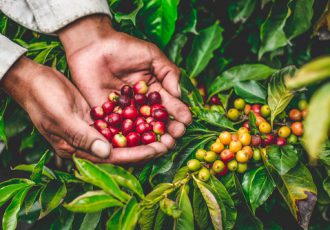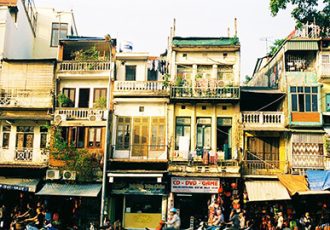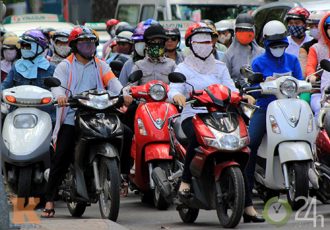Vietnam, located in the eastern part of Southeast Asia, a tropical region with monsoons, is a point of convergence of various ethnicities, and a crossroads of various civilizations. Its rather rugged relief with mountainous regions, plains and coasts, is another factor of ethnic complexity.
54 ethnic groups have been identified, including the Kinh or Viet, the main ethnic group that represents about 87% of the population.
Linguist families are used to define 8 major ethnic groups, these 8 groups have in common to share a common ancestor language.
Here they are:
- Mon Group – Khmer (Ba Na, Brau, Bru Van Kieu, Cho Ro, Co, Co Ho, Co Tu, Gie Trieng, Hre, Khang, Khmer, Kho Mu, Ma, Mang, M’nong, O Du, Ro Mam, Ta Oi, Xinh Mun, Xo Dang, and Xtieng)
- Thai group (Bo Y, Giay, Lao, Lu, Nung, San Chay, Tay and Thai)
- Tibeto Group – Burmese (Cong, Ha Nhi, La Hu, Lo Lo, Phu La and Si La)
- Austronesian Group (Cham, Chu Ru, E De, Gia Rai and Ra Glai)
- Viet Group – Muong (Chut, Kinh, Muong and Tho)
- Kadai Group (Co Lao, La Chi, La Ha and Pu Peo)
- Mong Group – Dao (Dao, H’Mong, and Pa Then)
- Han Group (Hoa, Ngai, and San Diu)
In this very comprehensive article, you will find the specificities of each ethnic minority in Vietnam
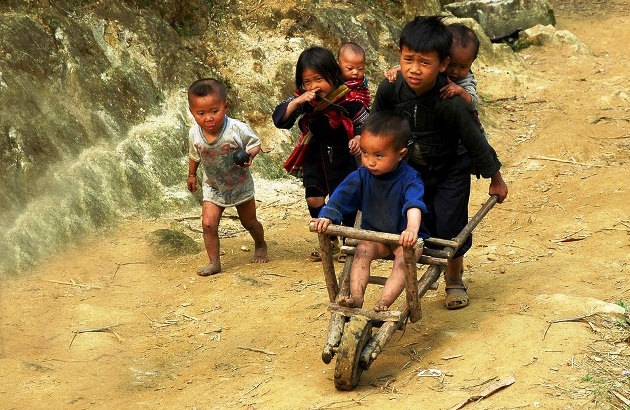
I – Mon-Khmer Group (Austro-Asian language family)
1. Ba Na
Other names: Bo Mâm, Roh, Kon kde, Ala, Kông, Kpang Kông…
Population: 136,859 inhabitants.
Ba Na ethnic minorities live in the provinces of Gia Lai, and Kon Tum in Vietnam and in the west of Binh Dinh, Phu Yen, and Khanh Hoa provinces. They live in houses on stilts, and plant rice on dry fields or rais (slash-and-burn), specialized or diversified horticulture has also appeared for a long time. They practice breeding and crafts (weaving, ceramics, forge).
2. Braus
Other names: Brao
Population: 231 inhabitants:
The Braus live in the villages of Dac Me, Bo Y commune, Kon Tum province of Vietnam’s Central Highlands region. They live in houses on stilts and practice slash-and-burn cultivation of rice (ordinary and sticky), maize, and cassava. Braus eat mostly sticky rice cooked over a fire in a stretch of bamboo or regular rice cooked in water in a terracotta pot. The main drink is ruou Cân (alcohol fermented and sipped with a bamboo torch) the Brâu woman wears only a loincloth, the torso being naked. She likes large glass necklaces, bracelets and especially earrings made of ivory or yellow bamboo slices. Everyone smokes the water pipe.
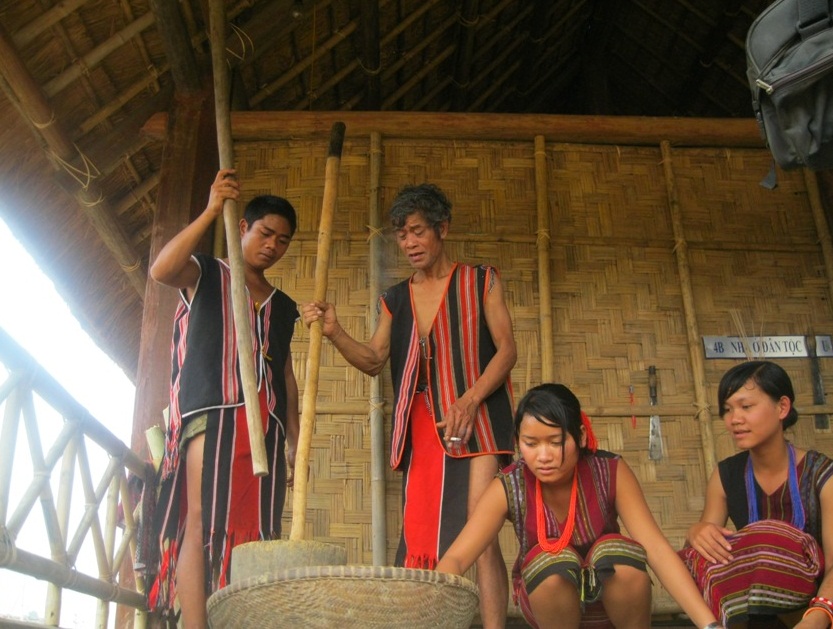
3. Bru Vân Kiêu
Proper name: Bru, according to some researchers.
Other appellations: Bru, Vân Kiêus
Population: 40. 132 inhabitants.
The Bru Vân Kiêu live on the highlands of the Truong Son range, in the west of the provinces of Quang Tri, Thua Thien Hue-Quang Binh. Each village is a gathering point. Each family has a private house on stilts, the fireplace is installed on the ground. The Bru mainly plant rice on the milpa. Apart from growing rice, they still plant cassava, squash, banana, pineapple, eggplant, sugar cane, and raise buffalo, beef, pig, poultry, dog and also make handicrafts. According to custom, the man wears a langouti, the woman a loincloth, and the jacket, sleeveless, slips on by the head. They attach importance to ancestor worship.
4. Cho Ro
Autres appellations: (Chau Ro, Do Ro, Chro, Thuong)
Population: 15.022 habitants.
The Cho Ro live in communities in the lowland mountainous region of southwest Dong Nai province. They are more numerous in the communes of Xuan Binh, Xuan Truong, Xuan Tho, Xuan Phu, etc. The Cho Ro practice slashes and burns on the grapes. They clear the land, burn the vegetation and then make holes and throw the seeds in. They still cultivate squash, loofah, cowpea, manioc, rice and sesame… The men wear the langouti, and the women the one-piece loincloth. In summer, they are bare-chested or wear a short-sleeved jacket. In winter, they often drape themselves in a plaid. Women often wear necklaces made of glass, bronze, silver or aluminium. They practice ancestor worship.
5. Co
Other appellations: Cua, Trâu.
Population: 22,649 inhabitants.
The Co live in community in Tra Bông and Tra Mi, in the north-west of Quang Ngai Province and the south-west of Quang Nam Province. The houses are built on stilts, and the doors open at the ends. In recent times, the fashion is to build private houses built on the same ground as do the Viet of the region. The Cos mainly practice slash-and-burn farming, which is the main resource. They practice alternating cultures, polyculture and rotation. The Cos mainly buy fabrics and clothes from the Xo Dang and the Viets. In the tradition, the man wears the langouti and remains shirtless, the woman surrounds herself with a loincloth and wears a short-sleeved jacket. The Co love music and apart from the drums of three gongs which is the most used instrument, there is the drum, the string instruments. The popular Xru tunes are widely known. Tales, legends and fables are part of a rich literary heritage.
6. Co Ho
Local groups: Xrê, Nôp( Tu Nôp), Co Don, Chil, Lat, To Ring( Tring).
Population: 92,190 inhabitants.
The Co Ho live mainly in Lam Dong province. They live in longhouses built on stilts with a two-element roof covered with straw, braided bamboo partitions covering straw to combat the cold, and a staircase. They practice rice cultivation in flooded rice fields, and animal husbandry; buffaloes, oxen, pigs, poultry, etc… Men wear the langouti, women wear the loincloth. The langouti is a piece of cloth 1.5 to 2 m long decorated with patterns along the entire length. The loincloth is black in colour and bordered by white patterns. Ornaments include glass necklaces and bracelets, and lobe rings. Ordinary foods are rice, corn, cassava… mixed with ferments prepared from wild plants. Men smoke water pipes, they practice ancestor worship. The Co Ho script was invented in the early twentieth century on the basis of Latin characters. They have a rich literary heritage with lyrical poems and music.

7. Co Tu
Other names: Ca Tu, Ka Tu
Population: 36,967 inhabitants.
The Co Tu live in the districts of Hiên, Giang (Quang Nam province), Phu Lôc, A Luoi (Thua Thien province – Hue). They live mainly from slash-and-burn cultivation, clearing brush with axes and machetes, burning vegetation and putting seeds in poquet. The Co Tu first like indigo fabric clothes decorated with lead patterns and secondly those decorated with patterns including white glassware. Men wear langouti and in general, remain shirtless. Women wear a long sheath skirt that goes up high enough to cover the chest or a shorter skirt fitted with a sleeveless jacket. They practice ancestor worship. The Co Tu have a treasure trove of tales about the origin of man, about society, about the creation of lineages.
8. Gié-Triêng
Other appellations: Cà Giang, Giang Rây,
Population: 26,924 inhabitants
The Gié-Triêng live in the Dac Giay district (Kon Tum province), or in the province of Quang Nam, they live in very long houses on stilts with several homes. It is the most widespread traditional architectural form. According to tradition, men wear langouti, stay shirtless and wrap themselves in a blanket when it’s cold. Women dress in a jacket and loincloth, sometimes a long sheath skirt that goes up to the top of the chest. They like to wear a lot of adornments: Necklaces, rings, bracelets in silver, copper or glassware, those of wealthy family also wear ivory earrings. The Gié-Triêng live mainly from slash-and-burn cultivation. Apart from rice, they also practice the cultivation of maize, cassava, millet, sweet potato, taro, squash, tobacco, cotton, sugar cane, banana … and the breeding of animals such as chickens, pigs, dogs, buffaloes, daily food comes from gathering, hunting or fishing.
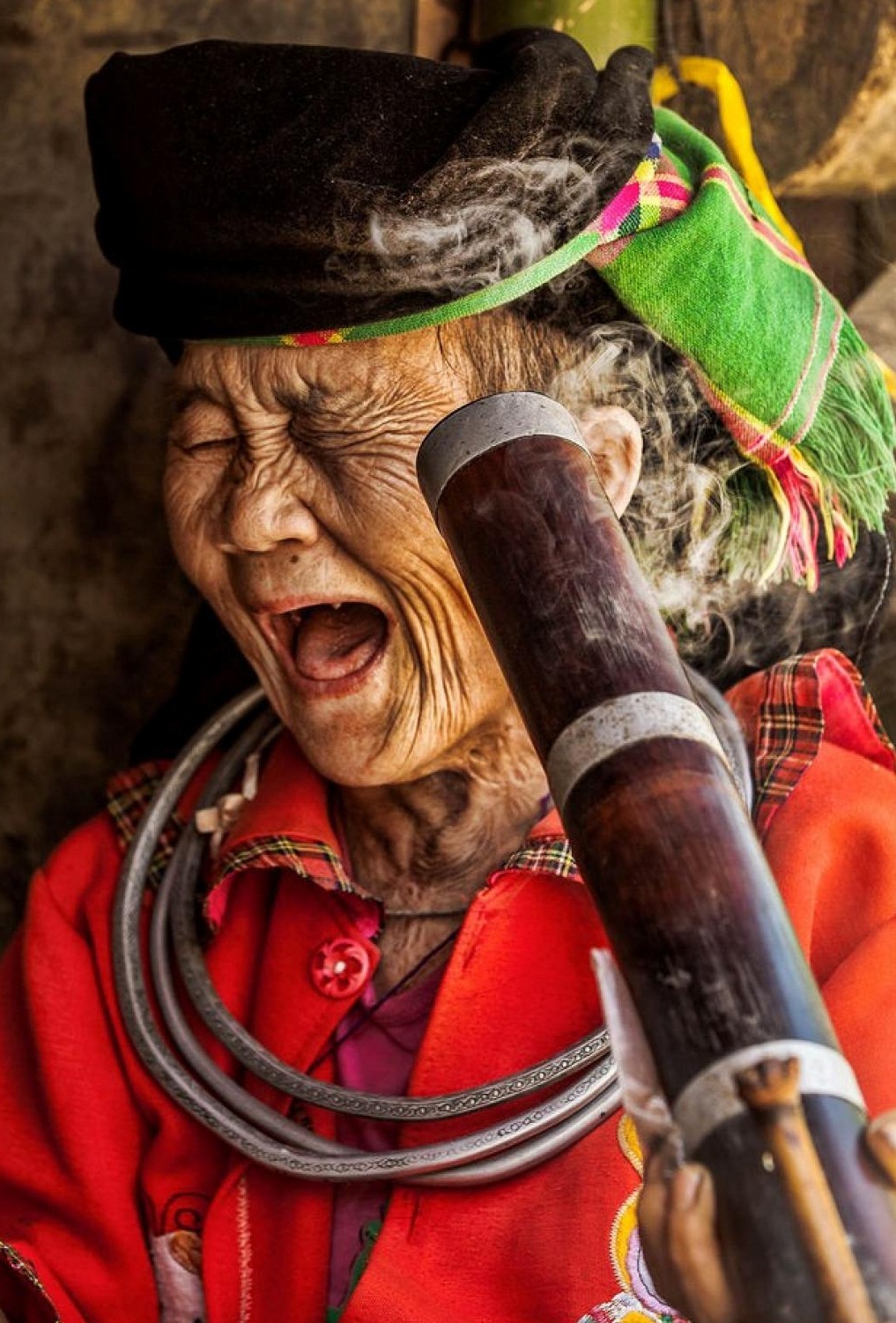 Vieille femme ethnique Hmong au Nord vietnamien
Vieille femme ethnique Hmong au Nord vietnamien
9.Les Khang
Other appellations: Cà Giang, Giang Rây,
Population: 26,924 inhabitants
The Gié-Triêng live in the Dac Giay district (Kon Tum province), or in the province of Quang Nam, they live in very long houses on stilts with several homes. It is the most widespread traditional architectural form. According to tradition, men wear langouti, stay shirtless and wrap themselves in a blanket when it’s cold. Women dress in a jacket and loincloth, sometimes a long sheath skirt that goes up to the top of the chest. They like to wear a lot of adornments: Necklaces, rings, bracelets in silver, copper or glassware, and those of wealthy families also wear ivory earrings. The Gié-Triêng live mainly from slash-and-burn cultivation. Apart from rice, they also practice the cultivation of maize, cassava, millet, sweet potato, taro, squash, tobacco, cotton, sugar cane, banana … and the breeding of animals such as chickens, pigs, dogs, buffaloes, daily food comes from gathering, hunting or fishing.
10.Khmer
Other names: Cur, Cul, Tho, Viet of Khmer origin, Khmer Krom.
Population: 895,299 inhabitants constituting the largest ethnic group of the Mon-Kmer language group in Vietnam.
The Khmer inhabit the Mekong Delta on three ecosystems: Inland Plains, alkaline-soled coastline, and southwestern hills on the border with Cambodia. Once they erected houses on stilts, now they build houses without floors, with thatched walls and roofs. In the past, men and women all wore silk Sà Rông, which they weaved themselves. Nowadays, young people prefer to dress in the European style with pants and a shirt. The older ones wear a loose black ba suit. Men of affluent condition prefer the white ba with a turban checkered scarf on the head or thrown on the shoulder. The Khmer live off agriculture, with the soc and rice fields flooded. They grow more than 150 varieties of ordinary and sticky rice. The Khmer celebrate the worship of the Buddha, their ancestors and certain agricultural rites, such as the cult of the Genius of the rice fields (neak Ta Xiê), that of invocation of the soul of rice (Ok Ang leok). The Khmer have a treasure trove of myths, legends, fairy tales, and fables, as well as a traditional theatre.
11. Kho Mu
Other names: (Xa, Câu, Kha, Klâu, Thênh, Tênh)
Population: 42,853 inhabitants.
The inhabitants of this ethnic group are now spreading in the provinces of Yên Bai, Son La, Lai Chau. Nomads build small, scattered villages, with houses on stilts with braided bamboo walls and floors. Kho Mu dress like Thais with the difference that Kho Mu women’s blouses are adorned with coins and shells. The Kho Mu live mainly from the itinerant culture, the Kho Mu are still called “the Xa-fire eaters”. In the belief of this ethnic group, there are five kinds of ghosts (or Spirits) important: Ghost of Heaven, Ghost of Earth, Ghost of the Octopus, Ghost of ancestors and Ghost of the house.
12. Ma
Population: 25,436 inhabitants:
The Ma live grouped in villages on a very limited territory, in the highland regions of Bao Lôc, Di Linh, in the Dong Nai basin (Lâm Dông province). They live in houses on stilts of great length built with a variety of bamboo. They mainly practise slash-and-burn rice, maize, tuberaceae, tobacco and animal husbandry: buffaloes, cows, pigs, and poultry. Ordinary rice with spicy salt, lemongrass, fresh bamboo shoots, and some forest vegetables is the ordinary dishes of this ethnic group. The Ma also like to drink rice alcohol and smoke with a water pipe. The ma’s female costume consists of a skirt, wrapped around the body and falling above the calf, a sticky tunic down to the belt and which slips on like a sweater. Men wear a loincloth, a jacket split into 2 sides. Women like to wear glass necklaces in rich colours and in men, copper rings on the wrists. The Ma believe in the existence of several geniuses (Yang) whom they worship: The genius of the house (Yang Hiu), that of rice (Yang Koi), that of the mountain (Yang Bonom), and the worship of ancestors.

Ethical children at the party
13. Mang
Other appellations (Mang, Xa Mang, Nieng O, Xa Ba O)
Population: 2. 247 inhabitants.
The Mang mainly practice slash-and-burn itinerant cultivation of rice, vegetables, cassava etc. And the breeding of buffaloes, oxen, goats, chickens, pigs etc. In addition, gathering and hunting, play an important role in the economy of the Mangs. A striking feature in the Mang women’s suit: The piece of white cloth embroidered with rows of decorative motifs at the belt and chest-showing the white breast cover and necklace. The black skirt is embellished with decorative motifs on the hem. Note: the leggings are formed of strips of fabrics of different colours sewn together.
14. Mnông
Population: 67,340 inhabitants:
Currently, the Mnông live in local groups, especially in the districts of Lacs, Mdrac, Dac Nông, Buôn Dôn… in the province of Dac Lac. The Mnông cultivate flooded rice and have handicrafts among which basketry is the most widespread to provide household utensils made of bamboo wicker and leaf. They are also excellent in ceramics. The inhabitants of Ban Dôn in particular are renowned for hunting and domesticating elephants. Mnông men wear langouti and remain shirtless. The woman, on the other hand, wears the loincloth and also remains shirtless.
15.O Du
Autre appellation: Tay, Hat
Population: 194 habitants
Actuellement les O Du vivent principalement dans 2 villages, Xôp Pôt et Kim Hoà dans la commune Kim Da dans la province de Nghe An, ils habitent dans des maisons sur pilotis et cultivent le riz dans les rizières en terrasses, ils cultivent encore le manioc, les cucurbitacées, le maïs, le nénuphar, la fève. La cueillette et la chasse tiennent toujours une place très importante dans la vie des O Du, l’élevage des bovins, porcs, poulets, chèvres est très développé. Aujourd’hui les hommes et les femmes des O Du sont habillés de la même façon que les Thai et les Viet de la région. Ils pratiquent le culte des ancêtres.

16. Ro Mam
Population: 286 inhabitants
The Ro Man live mainly in the province of Kon Tum of the Central Highlands, they live in long houses on stilts the typical feature of the architecture of the traditional Ro Mam house consists of carefully carved ivory, fixed at the end of 4 columns located at the 4 corners of the house. They live on slash-and-burn cultivation, especially sticky rice and a supplement of ordinary rice, maize, and cassava. Among the crafts, cotton cultivation, and weaving is the most developed. Ro Mam women wear skirt and stay shirtless, they like to wear metal, bamboo or wooden earrings. They practice ancestor worship.
17. Ta Oi
Other names: (Tà ôi, Pa Cô, Tà Uôt, Ken Tua ect)
Population: 26,044 inhabitants
The Tà ôi live in an area stretching from the west of Quang Tri province to the west of Thua-Thien-Hue. They clump together in villages: Their houses on stilts are long, slash-and-burn cultivation is a main resource of the Ta ôi, hunting, fishing, and gathering are still very important to them, and they also make handicrafts made of bamboo and braided rattan. The commercial relations with Laos are quite important. Women wear a short skirt and a jacket or a long skirt going up to the chest, men sometimes wear a langouti and a jacket but usually, they are shirtless. Traditional ornaments are bracelets on the arms and legs, necklaces, and earrings in copper, silver or courbaril.
18. Xinh Mun
Population: 10,890 inhabitants
The Xin Mun have lived for a very long time in the northwestern regions of Vietnam, they specialize in slash-and-burn agriculture, and a small part of the population practices flooded rice cultivation. The costume of the Xinh Mun is analogous to that of the Thai, they live in houses on stilts, which have a roof in the shape of a turtle shell and practice ancestor worship.
19. Xo Dang
Other names: Hdang, Con Lan, Brila.
Population; 96,766 inhabitants
The Xo Dang habitat area is in Kon Tum province and in Tra My, Phuoc Son districts of Quang Nam province, part of the Xo Dang practices agriculture on flooded rice fields. For most Xo Dang, the slash-and-burn economy plays a preponderant role, apart from rice, Xo Dang also grows millet, maize, cassava, squash, tobacco, melon, banana, sugar cane, etc. Animals traditionally bred are buffaloes, goats, pigs, dogs, roosters, and chickens. Gathering, hunting and fishing are no less important. They are excellent in crafts. Men are shirtless and wear a lagouti. Women dress in jackets and skirts. The traditional house of the Xo Dang villages is grandiose, tall and more beautiful than all the other houses, it serves as a place of reception for visitors, a meeting hall, place of festivities. The Xo Dang practice ancestor worship, they believe in the forces of nature, and they worship important gods like a sun god, mountain god, rice god, water god, etc.
20.Xtiêng
Population: 50,194 inhabitants:
The Xtiêng have clumped together in Binh Phuoc province, in small numbers also in Binh Duong, Tay Ninh and Dong Nai provinces. The main food resource is rice, about 80% of rice comes from slash-and-burn. They also practice animal and poultry farming, etc. They live in houses with 4 roofs, covered with thatch, rounded in shape with gables, the edge of the roofs approaching the ground, with the entrance door in the middle of the gables, remains quite widespread. Men are shirtless and dress in langouti; women wear a jacket or also have a bare chest and surround themselves with a skirt. There are several ceremonies of different importance in the life of the Xtiêng. Among them, is the buffalo sacrifice ceremony which is the largest, and is celebrated on the occasion of a good harvest, a victory against the enemy, rejoicing, prosperous work, and the birth of a child.
II – Thais Group
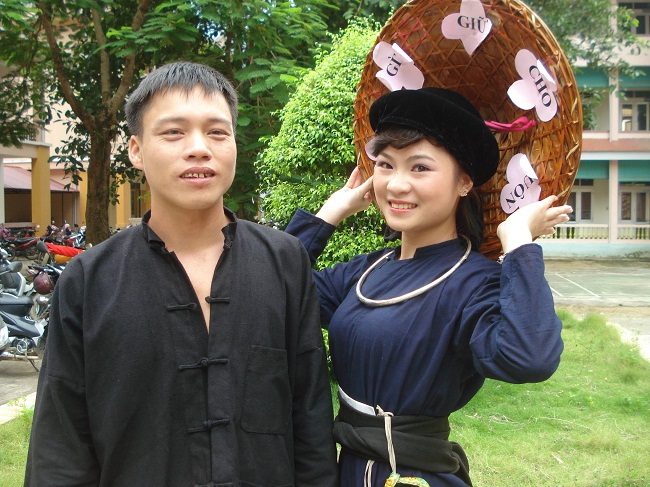
1.Bo Y
Other names: Chung Cha, Trong Gia…
Population: 1,420 inhabitants.
The Bo Y live in Quang Ba (HaGiang Province) and Muong Khuong in Lao Cai Province. They live in houses with a two-part roof covered with straw, wood or tiles, and mud walls. They are divided into three spaces and include a mid-height floor serving as a food depot and dormitory for single boys.
The Bô Y who excelled in the cultivation of aquatic rice live mainly from the cultivation of slash-and-burn maize because as soon as they came to Vietnam they settled in high regions. In addition to cattle and poultry, they also raise fish in rice fields and practice many craft activities such as weaving, forging, ceramics, stone carving, silver inlay, basketry, carpentry … The original beauty of Bô Y women’s clothing comes from their cool colours, batik patterns and apron. Weaving, dyeing and making traditional clothes are disappearing. They practice the worship of Heaven, that of the home, that of the ancestors.
2. Lao
Population: 9,614 inhabitants:
The Lao live interspersed with the Thai, Lu, Kho Mu of the Dien Bien, Phong Thô districts of Lai Chau Province and Song Ma District. They live in houses on stilts, of great width, and well ventilated with finely carved columns. The Lao practice rice cultivation in flooded land for which they have a rational irrigation method. They also grow slash-and-burn crops and raise pets and poultry. Family crafts are particularly developed. Lao women wear tight skirts at chest height and down to the calves. The hem is embroidered with floral patterns or richly decorated with ornamental patterns in bright and light colours. Their tunic, short, lays bare the top of the bust. Their silver hairpins are finely chiselled and their damn khan stake is embroidered with skill. The male tunic has many similarities with that of Thai men. The Lao have a script that comes from Sanskrit. Each family has an altar for ancestor worship.
3. Lu
Other names: (Phu Lu, Nhuon, Duon)
Population: 3,684 inhabitants
Lu lives in the districts of Phong Tho, Sin Ho, Dien Bien (Lai Chau Province). They live in houses on stilts whose roofs, with four sides, are protruding so as to form a kind of veranda. The Lu are the creators of arroyos and phai (a kind of rudimentary hydraulic “works” consisting of embankments or wooden planks placed on top of each other, to retain water). Weaving develops with tho Câm fabrics with rich and aesthetic decorative patterns. The Lu attaches great importance to the weaving of fabrics for clothing, blankets, and mattresses. This work is only practised by women. The Lu practice the worship of their ancestors and that of the Buddha.
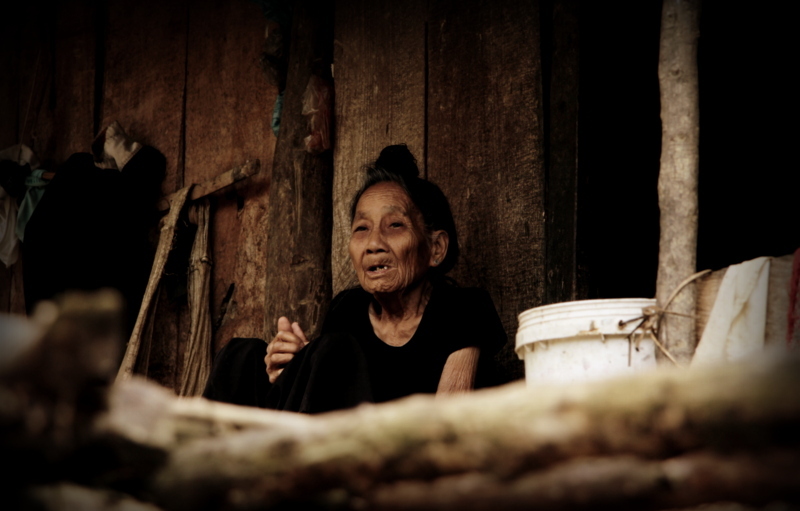
4. Nung
Population: 705,709 inhabitants:
The Nungs are settled in the northeastern provinces of the country. They often cohabit with the Tay. Most live in houses on stilts, some in houses on the ground, with adobe or unfired brick walls. The Nungs are very skilled farmers, they live mainly on rice terraces and slash-and-burn. In addition to corn and rice, they also grow tubers, cucurbits, vegetables… They work in different crafts: weaving, forging, foundry, basketry, carpentry, papermaking etc. The traditional costume of the Nung is quite simple, the men wear an officer collar jacket, open on the front. Women wear the 5-sided jacket, buttoned in the right armpit and down to below the hip. The Nung practice ancestor worship, the general design of which they have with geniuses on each terrain, in the forest. Every year, the Nung worship genius at the foot of centuries-old trees or bizarrely shaped rocks in forbidden forests. Sli are alternating songs, a form of collective songs often exchanged between two young men and two young girls and sung by two choirs.
5. San Chay
Other appellations :(Chung, Trai)
Population: 114,012 inhabitants.
The San Chay habitat area is located in the north of our country. They live in houses on stilts similar to those of the Tay of the same region. The San Chay are skilled farmers in agriculture on flooded rice fields, but slash-and-burn still plays a big role in economic life, and this method of cultivation in holes dug with a hoe to make seeds persists to this day. Fishing plays an important role. The San Chay feed mainly on rice. Alcohol is used in large quantities, men smoke tobacco for water pipes, and women chew betel. Women dress in indigo-coloured skirts and tunics full of ornamental patterns on the back.
6. Tay
Population: 1,190,342 inhabitants
The Tays habitat area is in the valleys of the northeastern provinces of North Vietnam, from Quang Ninh, Bac Giang, Lang Son, Cao Bang, Bac Kan, Thai Nguyen, Ha Giang, Tuyen Quang to Yen Bai. They live in houses on stilts. The Tays are inhabitants whose agriculture on flooded rice fields is a tradition, breeding is very developed with several species of animals and livestock. The Tay costume has almost no ornamental motif. Except for the women of the Pa Di group who have ornamental patterns with collars and upper hems, whose sleeve is composed of sections of coloured fabric. The most characteristic feature of the pa Di women’s costume is the house-shaped hat. The Tay essentially worships ancestors. They also worship the Genius of the Soil, the Genius of the Home and the Goddess of Birth.
7. Thai
Other names: (Tay Thanh, Man Thanh, Tay Muong, Tay Do, Tho)
Population: 1,040,549 inhabitants
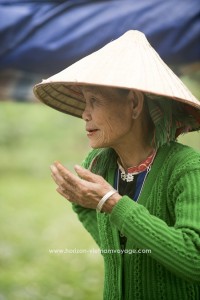
Thais live mainly in the provinces of Hoa Binh, Son La in western Vietnam. They are excellent in flooded rice farming with a highly developed technique. In addition, they also work on slash-and-burn to grow rice, corn, food crops, especially cotton, dyeing plants, and white mulberry used in the manufacture of silk.
Thai girls make themselves beautiful with their short jackets, rich in colours, adorned with a row of silver buttons in the shape of butterflies, spiders and tightly surrounding the body, and matching well with the dark-coloured cloth skirt with a belt in green silk band and with a silver chain hanging on the hip. They dress in a black tunic, split between the armpits, or a tunic strung by the head, leaving uncovered a part of the throat with the front decorated with a row of butterfly buttons, curved, puffy at the shoulders, having some ornaments in the armpits and front of the shoulders. Thai men wear short pants with the top edge as a belt and a jacket split on the front with pockets into both sides.
They practice ancestor worship and Buddhism.
III – Tibeto Group – Burmese
1. Cong
Other names: Xam khoong, Phuy A.
Population: 1,261 inhabitants.
The Cong live mainly in the northwestern provinces of Vietnam, in houses built on stilts. They mainly practise firewood burning. Gathering plays a very important role, they excel in making red-dyed rattan mats and bamboo objects. The Công dress like the Thai. Some families still keep traditional clothes made with fabric made by the Laotians, the hair tied in a bun above the head is the distinctive sign of a married Công woman. They practice ancestor worship and Buddhism.
2. Ha Nhi
Other names: U Ni, Xa Ni.
Populations: 12. 490 inhabitants.
The Ha Ni spread along the border with China and Laos, and are concentrated in Bat Xat districts (Lao Cai province, Muong Te, Lai Chau). They practice rice cultivation on rice terraces and on permanent burns that have been held for generations in Vietnam. The Ha Ni raise large cattle and farmyard birds freely. Cotton cultivation and artisanal weaving are also developed. Ha Nhi women excel in basketry. The conical hat made of braided bamboo is proof of this.
3. La Hu
Other names: (Xa, Co Xung, Khu Sung, Kha Quy, Co so, Nê Thu)
La Hu live on the high mountains of Pa U, Pa Vê communes of Muong Te district, Lai Châu province. They mainly practice itinerant culture. In recent years, they have gradually moved towards growing rice in rice terraces. They are famous for basketry. Hunting, fishing and gathering play a particularly important role in their economy. Their clothes consist of long tunics and pants. Usually, women wear a long-sleeved jacket, buttoned on the right side. The La Hu only celebrate the worship of their ancestors and relatives on new rice rite days, wedding days and funerals. It is not customary for the La Hu to worship the deceased on the anniversary of his death and the only offering presented at the altar of the ancestors is rice wrapped in a forest leaf.
4.LoLo
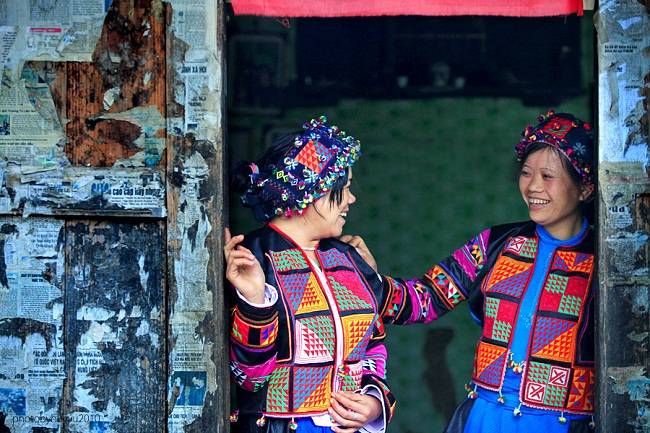
Other names: (Mun Di, Di, Man Di, La La, Qua La, O Man, Lu Loc Man)
Population: 3,134 inhabitants
Most Lô Lô live in houses with clay floors and adobe walls. The Lô Lô mainly practice rice cultivation in flooded rice fields and sedentary slash-and-burn cultivation with sticky rice, ordinary rice and maize as the main plants. Lô Lô men wear a suit in indigo blue, a turban folded in several turns. Many of them use water pipes for smoking. Lô Lô women are richly dressed in various decorative motifs. A characteristic feature of both groups is the use of multiple “methods” for assembling pieces and strips and a marked preference for bright colours.
5.Phu La
Other names: Xa O, Can Thin,
Population: 6,500 inhabitants:
The Phu La live in small villages. Depending on the locality, we live in a house on the same ground or on stilts. The attic is built away from the house, sheltered from fire. The Phu La practice slash-and-burn cultivation in rice terraces. The Phu La maintain until now the cultivation of cotton and weaving to satisfy the family’s clothing needs. Taking advantage of the moments when she is at home, the woman untangles the cotton and she runs it on the path to slash and burn.
6. Sila
Other names: Kha Pe,
Population: 594 inhabitants
The Sila are clustered in a few villages in Muong Te District, Lai Chau Province, they live in houses on the ground. Before, the Sila had specialized in itinerant agriculture, but today they live mainly from growing rice and maize on rice fields and slash-and-burn, gathering also plays a very important role in their lives. Women dress in skirts with part of the centre uncovered. The front of the tunic is decorated with silver coins, the collar and sleeves are decorated with stripes of fabrics of different colours, and the skirt is black or indigo in colour, fixed on the body from behind. The turban differs according to age and marital status. Young girls Si La surround their hair around their heads is capped with a simple white turban. Married women, raise their hair in a bun and wear indigo-black turbans.
IV – Austronesian Group

1. Cham
Other names: (Chàm, chiêm, Chiêm Thanh, Cham Pa, Hoi..)
Population: 98,971 inhabitants
The Cham live mainly in the provinces of Ninh Thuan, Binh Thuan of Vietnam, they live in single-storey houses with tiled or thatched roofs. They are traditionally aquatic rice planters, they are excellent in irrigation and fruit tree planting work. The Cham of Nam Bo live mainly from fishing, artisanal weaving, small trade, and agriculture being a secondary occupation. The craft that makes the fame of chams is weaving, silk and the manual manufacture of pottery. Trade with neighbouring populations has been around for a long time. Both men and women wear the loincloth. The weaving of cotton brocatelle by chams is expanding and they adapt it to the context of the commodity economy while meeting the needs of tourists. The tower-shaped temples constitute the cultural heritage of the chams, built for several centuries, they remain linked to the spiritual life of the inhabitants.
2. Chu Ru
Other appellations (Cho, Ru, Kru, Thuong.)
Population: 10,746 inhabitants
The Chu Ru live in Lam Dong province, Binh Thuan, Ninh Thuan, they live in houses on bamboo or wooden stilts, covered with straw. The Chu Ru lead a sedentary life based on an agricultural tradition. They cultivate both flooded and dry fields, they develop livestock and poultry farming. Hunting and fishing are part of everyday life. Family crafts (weaving, pottery) are widespread. Weaving is not developed clothes and complements. The traditional feminine dress of the Chu Ru consists of a loincloth and a piece of cloth thrown on one shoulder. White pants, a black tunic and a white turban are the traditional dress that the man wears on special occasions weddings, parties, funerals…
3. Ede
Other names: (Anak, Ea De, Ra De, E De, Egar, De)
Population: 194,710 inhabitants.
The E Dê live mainly in Dac Lac province, the south of Gia Lai province and the west of Phu yên and Khanh Hoa provinces. The E Dê practice the cultivation of flooded rice. The most numerous farm animals and poultry are pigs, buffaloes and chickens, but they are mainly used only for ritual sacrifices. The traditional weaving on the looms of Indonesian type quite rudimentary makes it possible to manufacture like so many other ethnic groups, fabrics for langoutis, blankets, bags … of great solidity. It is also the art of weaving patterns with particular colours and designs specific to the E Dê. Women E Dê wear a loincloth that goes down to the feet, in summer they remain shirtless or wear a short jacket strung by the head. Men wear the langouti and a jacket of the same kind. When it’s cold, men and women drape themselves in a blanket. They have the custom of dyeing their teeth black and chewing betel.
4. Gia Rai
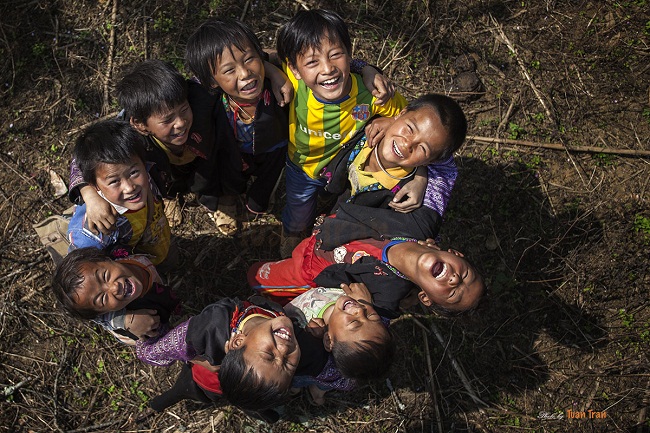
Other names: (Gio Ray, Cho Ray)
Population: 242,291 inhabitants.
The Gai Rai are among the first ethnic groups living in the mountainous regions of the Central Highlands of Vietnam. Agriculture is the basis of the activities of this ethnic group. They give importance to the family breeding of buffalo, oxen, horses, elephants, pigs, chickens, dogs… The men of the Gia Rai wear the lagouti in white fabric striped with bands of various colours, and the women wear the indigo loincloth (40mX1m) with a decorative stripe down. The Gia Rai practice ancestor worship and that of the geniuses of Heaven during a feast with buffalo sacrifice. There is always a gong show. The men dressed in a langouti and draped in a decorated blanket, beat the gongs as they dance around the sacrifice pole.
V – Viet Group – Muong
1. Chut
Other appellations: Ruc, Arem, Sach.
Population: 2,427 inhabitants.
The Chut lived in the Viet settlement area in the districts of Bô Trach and Quang Binh. They practice agriculture on slash-and-burn, nomadism and live on hunting and gathering. The chuts of the Ruc group are renowned for their technique of climbing trees to pick honey from hives. Using rattan vines, they make knots with a location for the foot as they climb. They practice ancestor worship.
2. Kinh
Population: 55,900,224 inhabitants,
The Kinhs make up 86.83% of Vietnam’s population.
The Kinh settled in all regions of Vietnam from north to south. They live in crossing houses with three parts; in the middle of the house is the altar of the ancestors. Agriculture on flooded rice fields was formed and developed very early among the Viet through generations in generations. The breeding of pigs, livestock, farmyard animals, and fish farming are highly developed. The buffalo in particular has become the “bulk of the fortune” of the farmer. The Viet are famous for their dexterity in craftsmanship, they have developed hundreds of trades in which they have reached a high level. District markets are still thriving. In the past, men wore wide-forked trousers, brown short jackets (in Tonkin) or black (in Cochinchina). The women dressed in black skirts, breast covers, brown jackets, and black reapers. At parties, women wear silk tunic. Ancestor worship is a spiritual activity of primary importance for the Viet.
3.The Muong
Population: 914,596 inhabitants.
The Muongs live grouped in villages, hamlets at the foot of the mountains, on the hillsides, slopes, near the rivers in Hoa Binh, Thanh Hoa, Phu Tho. The cultivation of flooded rice fields is the main activity, rice is the main food. The Muong also practice slash and burn agriculture, domestic animal husbandry, hunting, fishing, gathering and handicrafts (weaving, knitting, etc.). The Muong women’s costume, distinguished and discreet, includes a white rectangular turban, a short jacket, an ankle-length skirt, a breast covering and common silver string jewellery with a box of betel quid in the shape of a peach, tiger or bear claws. Both women and men like to smoke tobacco with a large water pipe. There is still a custom among women to pass the same cigarette from one to the other.
4. Tho
Other names: (Nguoi nha lang, Muog, con Kha, Xa La Vang)
Population: 51,274 inhabitants:
The Thos live mainly in western districts of Nghe An, they clump together in dense villages without a determined arrangement. They live in houses on stilts. The Thô have as their main resources slash-and-burn, only a small part practices the cultivation on flooded rice fields. The main food plant is rice, followed by cassava and maize. The habits and customs of the Tho are very varied, sometimes contradictory. Among other minorities, the white turban is a sign of mourning, but among the Thô and Muong, the white turban is worn every day to enhance the beauty of the costume. The Tho revere several geniuses, especially geniuses regarding the war against the aggressors and the clearing of land.
VI – Kadai Group (Co Lao, La Chi, La Ha, and Pu Peo)
1. Co Lao
Other names:( Ho Ki, Voa De).
Population: 1,473 inhabitants.
The Co Laos are grouped into villages of 15 to 20 houses with three cobblestones with two bamboo lean-tos. The Co Lao woman wears a jacket that falls just below the knee. The jacket is adorned with bands of fabric of different colours on the upper hem, on the front and on the sleeves. Part of the Co Laos that live in the steep mountainous regions practice slash-and-burn cultivation or on small plots of land embedded between the rocks. Maize is the main crop. Craftsmanship among Co Lao is also developed, they practice ancestor worship.
2. La Chi
Other names: Tho Den (Black Tho), Man, Xa.
Population: 7,863 inhabitants.
The La Chis are concentrated in villages on the hills of land, under the districts Hoang Su Phi, Xi Man (Ha Giang). Their dwelling includes a part without a floor and one on stilts. The La Chi are sedentary inhabitants, they know how to develop rice terraces on the hillsides and grow rice in flooded rice fields. They pick the ears of sticky rice by hand and sickle harvest the ordinary rice. La Chi men wear a five-sided tunic on their pants, buttoned on the right side. Having hair that goes down to the shoulders, they like to circle them with a pleated turban and carry in addition an indigo bag lined with red, to put tobacco and small objects. Women wear pants and some wear skirts. They wear a traditional four-sided tunic, open on the front, an embroidered breast cover and a cloth belt. They celebrate ancestor worship.
3. La Ha
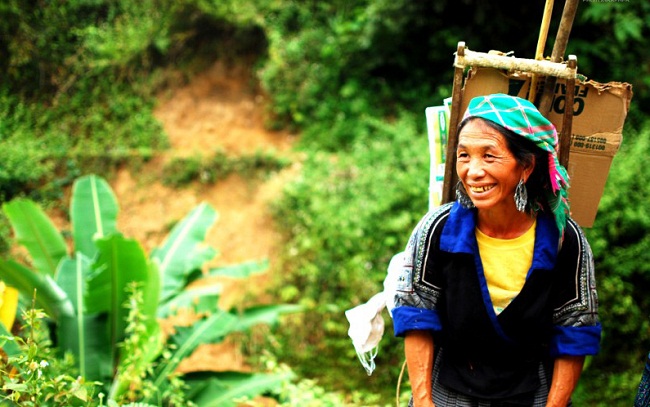
Population: 1,400 inhabitants:
The La Has live in houses on stilts, the inhabitants of this ethnic group are only beginning to cultivate in flooded rice fields, but their main and traditional form is slash-and-burn cultivation. Gathering and hunting are also very important. La Ha women dress like black Thais, and they have the traditional costume, teeth dyed black and they chew betel. Single girls wear a bun behind the back of their necks and married women on the top of their heads like black Thais.
4. Pupeo
Other appellations: (la Pa, Penti Lô Lô)
Population: 382 inhabitants.
The Pu Peo live mainly in Dong Van, Ha Giang province, once they lived in houses on stilts, today they build their houses on the same ground. The Pu Peo specialized in growing corn, and vegetables on slash-and-burn with advanced techniques such as slash-and-burn ploughing, fertilizer use, alternative cultivation, and successive cultivation. The skirt and women’s jacket are remarkable, with ornaments made by the application of pieces of coloured fabrics. Women wear jackets on top of each other. The way to bring the hair back to the front and holding it with a wooden comb is a typical feature of the Pu Peo culture.
VII – Mong Group – Dao (Dao, H’Mong, and Pa Then)
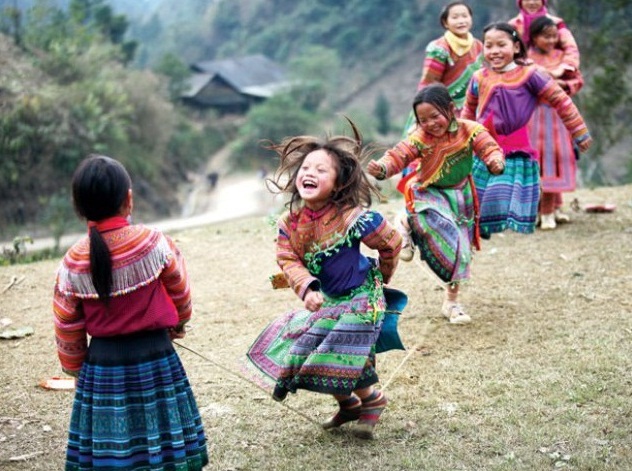
1. Hmong
The Hmong live mainly in the high-altitude regions of northern Vietnam, they are very numerous in the vicinity of Sapa, they live in houses on the ground well covered with wood. They grow both flooded and slash-and-burn rice.
The Hmong raise buffaloes, oxen, pigs, poultry and horses. The latter serves as a pack beast, very effective in high mountain regions. For this reason, the horse is very close to the Hmong families.
The inhabitants of the Hmong excel in crafts, such as basketry, forging, making horse saddles, furniture, wooden containers, rhamnoneuron paper, or silver ornaments. Hmong markets are based on both the barter of goods and the exchange of feelings between future couples. The Hmong Fair is a place for the exchange of goods, meetings between friends or between boys and girls. It is a typical feature of the Hmong of the high mountains bordering the North. We bring to the market, on the back of the horses’ corn, vegetables, bundles of wood, etc.
The fire pot “Thang co” is very popular with the Hmong, it consists of meat of all categories, bones, tripe, liver, heart and lung of beef cut into small pieces and cooked in a large pan.
2. Dao
Other names: (Man).
Population: 473,945 inhabitants
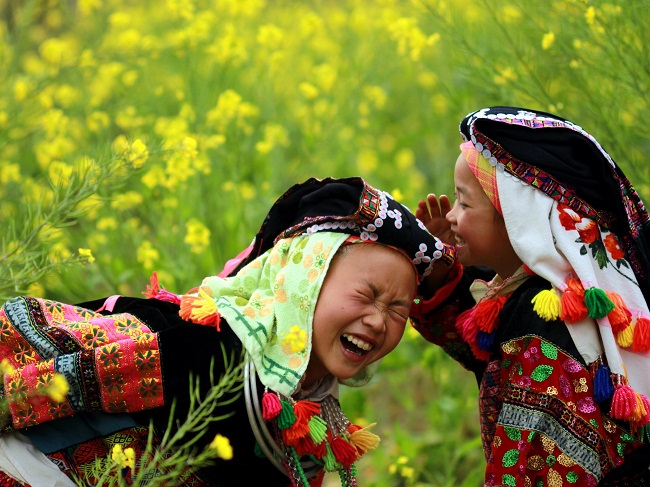
The Dao commonly live on the mountain slopes of the northern provinces. However, some groups such as the White Pants Dao live in the valleys and the Red Dao live at higher altitudes. The Dao commonly practice slash-and-burn agriculture, on plots of land embedded between rocks and in rice fields. The dominant form of cultivation depends on the region and the ethnic group in question. The white-pants Dao, the tunic Dao and the blue-jacket Dao work in the rice fields, the red Dao cultivates the plots between the rocks, and most of the other groups practise nomadic or sedentary grubbing. The main food crops are rice, corn, and vegetables such as squash or potatoes… they raise buffaloes, oxen, pigs and chickens on the mountain slopes, and even horses and goats at higher altitudes. The Dao woman wears a bun with a kerchief around it. The collar of her jacket is embroidered with brightly coloured patterns while eight-petal silver flowers are pinned to the breastplate. The Dao are still very good at cotton growing, weaving and crafts. The manufacture of silver objects, mainly necklaces, bracelets, neck or foot rings, earrings, chains, betel boxes… It is a trade that is passed on from father to son. The Dao practice ancestor worship and adopt primitive beliefs and agricultural rites while being influenced by Confucianism, Buddhism and especially Taoism. Cap Sac is a traditional ceremony for young Dao reaching adulthood.
3. Pa Then
Other names: (Meo, Meo Hoa, Meo Do, Bat dân tôc)
The Pa Thens settled in two provinces of Tuyên Quang and Hà Giang. Depending on the locality, the Pà Then usually live in houses built on the ground, on stilts, or on half-on-stilts. In the past, the Pa Then lived mainly from slash-and-burn farming. They grow rice, corn, vegetables of all kinds, legumes, and taro. The men of Pa Then often practice basketry and carpentry. Pa Then raise pets and poultry; cattle, goats, pigs, and chickens. The traditional costume of the Pà Then women still retains special elements. It includes Jacket, skirt, inner turban and outer turban, all brightly coloured. Some of the motifs adorning their clothes are almost similar to those of the Dao.
VIII – Han Group (Hoa, Ngai, and San Diu)
1. Hoa
Other Names: (khach, Tau)
Population: 900,185.
Farmers are grouped in villages often established at the foot of mountains, in the middle of fields, along the coast, or near water sources or communication routes. If they live in the countryside, the Hoa live from agriculture, especially from the cultivation of aquatic rice. If they live in towns and cities, they practice trade and service provision…. Their handicrafts are quite developed with, for example, ceramics (in Quang Ninh, Sông Be, Dong Nai), paper and incense sticks (in Ho Chi Minh City). Some of the Hoa people on the coast are engaged in saunage-making and fishing. In their production and trade activities, the Hoa are known to keep their word. Traditional Hoa clothing is only seen on a small number of people or in funeral and wedding rites. The women wear blouses with a high slit at the side or a five-panel jacket that reaches down to the knees. Women, especially young women, wear coloured clothes in pink, red and dark shades. Men’s suits consist of a black or indigo shirt, closed at the side with woven buttons, with a collar that is either upright, hanging or with four sides. The women like jewels, especially bracelets (in bronze, gold, stone, jade…), the traditional dances for the unicorn, the lion and the dragon are organized around the 23rd day of the 12th lunar month (departure of the Genie of the Home in the Sky) until the festival of Nguyên Tiêu (15th day of the 1st month). The teaching of Chinese characters, an irresistible demand of the Hoa in Vietnam, is facilitated by the party and the State of Vietnam. It is now widespread in the Hoa communities.
2.The Ngai
Other names: (Ngai, Ngai Lau Man, He, Dan, Le, Xuyen)
Population: 1,154 inhabitants.
The Ngai live in Bac Giang, Cao Bang, Lang son, or Quang Ninh. They live in houses without floors. The Ngai live mainly from flooded rice cultivation. They also grow maize, sweet potato, cassava and livestock… The crafts are remarkable such as the manufacture of bamboo blinds, mats, carpentry, masonry, forge etc. Ngai’s clothes are usually without embroidery. Men wear loose trousers, a jacket with three pockets. Women wear the 5-sided long jacket, buttoned under the right armpit. In addition to installing an altar for ancestor worship, the Ngai shamans also established the ancestral tablets for the worship of the founding ancestors (Taoism), Kouan yin of the South Sea (Buddhism) and the tutelary genius of the village.
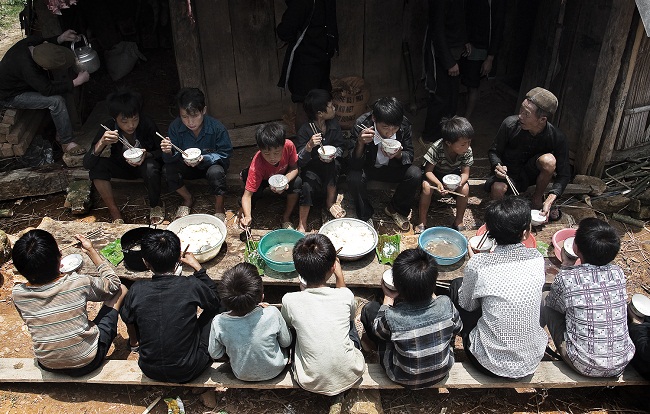
3. San Diu
Other names: (Trai, Trai Dat, Man Quan Coc, Man etc..)
Population: 91,530 inhabitants.
The San Diu live in villages in the middle region of Tonkin, in villages resembling those of the Vîêt, surrounded by bamboo hedges, they live in houses built on the ground, with the roof supported by earthen walls. The traditional costume of the women includes a black turban, a long dress (simple or lined); in the case of a lined dress, the inner one is white and the outer one is indigo and a little longer; a red breastplate; a white, pink or blue belt; an indigo skirt composed of two detached pieces having the same border and going down to the shin; white leggings. The men’s dress is similar to that of the Viet. The San Diu practice ancestor worship.
Note that some ethnic minorities listed in Vietnam are also present in China, you can consult the article of our partner: Ethnicities in China to know more.

